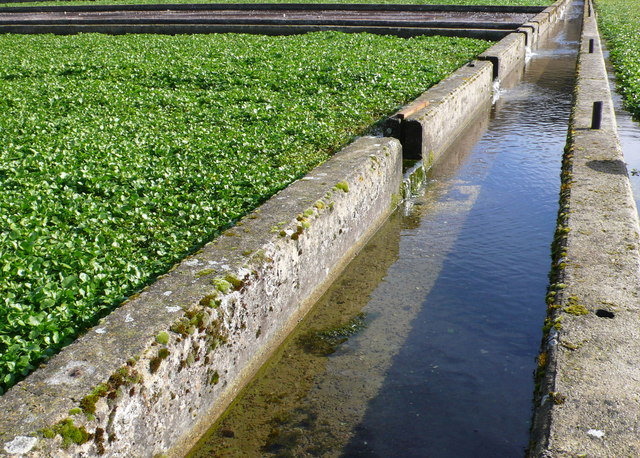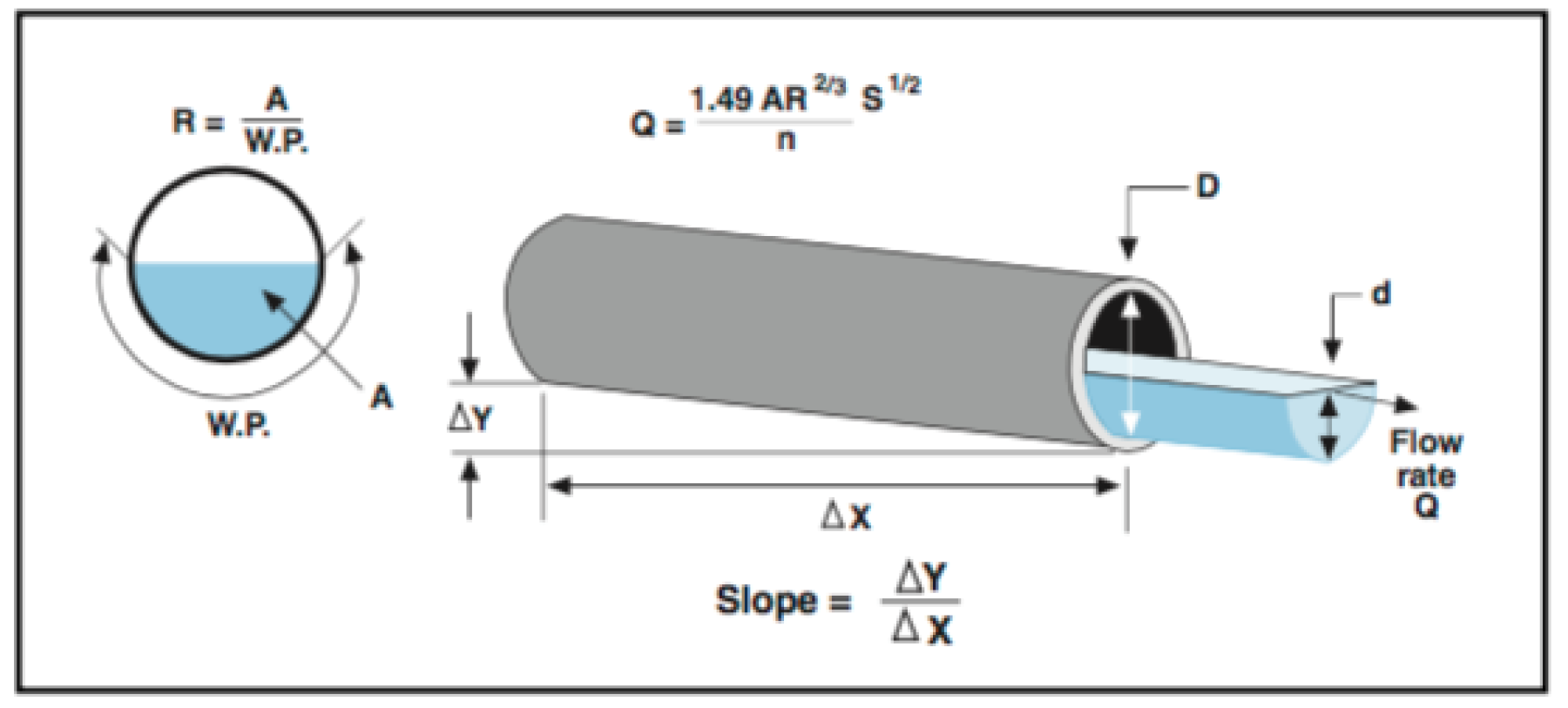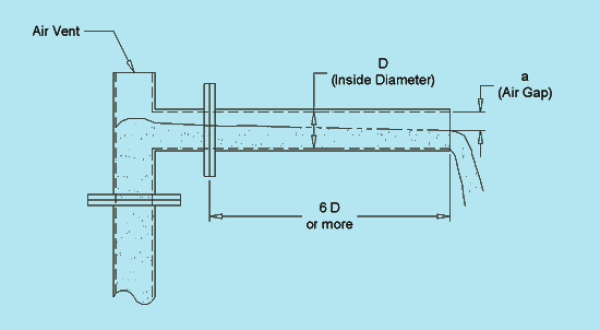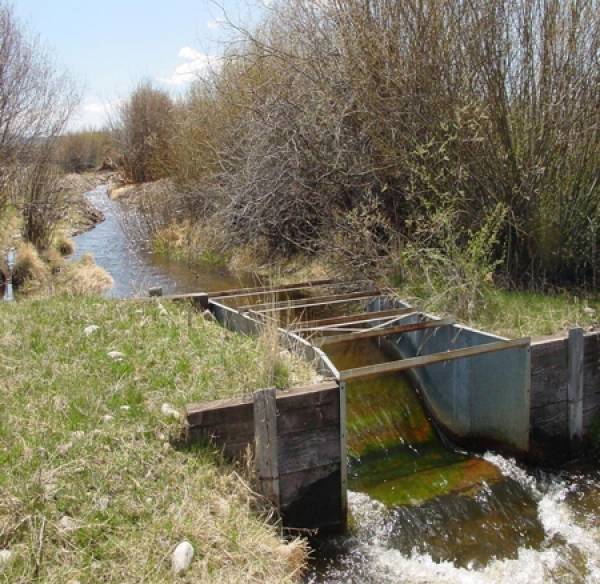This website uses a variety of cookies, which you consent to if you continue to use this site. You can read our Privacy Policy for
details about how these cookies are used, and to grant or withdraw your consent for certain types of cookies.
Manning Formula for Determining Open Channel Flows
One way of calculating open channel flow in pipes and channels without using a flume or weir is the Manning Formula. Although not as accurate as a hydraulic structure, the formula can provide a sufficient level of accuracy in some applications.

Measurement Conditions
- For best results with when applying the Manning formula:
- The channel should be straight for at least 200 feet (and preferrably 1,000 feet)
- The channel should be uniform in cross-section, slope, and roughness
- There sould be no rapids, dips, sudden contractions / expansions, or tributary flows
- The flow should not backup or be submerged
Manning Formula
The Manning formula uses water surface slope, cross-sectional area, and wetted perimeter of a length of uniform channel to determine the flow rate.
Equation — Manning Equation
Q = free flow rate (cfs / m3/s)
A = cross-sectional area of flow
R = hydraulic radius (cross-section area divided by wetted perimeter)
S = slope of the channel at the point of measurement
n = surface roughness (based upon channel material and condition)
K = constant dependent upon units
A = cross-sectional area of flow
R = hydraulic radius (cross-section area divided by wetted perimeter)
S = slope of the channel at the point of measurement
n = surface roughness (based upon channel material and condition)
K = constant dependent upon units

The cross-section area (A) and the hydraulic radius (R) are calculated for the given depth of the liquid in the channel at the moment of measurement (and not at some arbitrary maximum or minimum condition).
The slope (S) often has to be estimated based upon previous installation drawings of the channel or pipe, but true site measurements will provide a more accurate flow rate.
The roughness coefficient (n) is selected from standard reference roughnesses based upon the channel / pipe material and its condition.
Roughness Coefficients (n)
Nummerous n-values have been calculated for a variety of streams, channels, and pipes. Usuallly the values are given as a range (minimum - normal - maximum) for a particular channel type or material.
There are numerous factors that affect n-values, including:
- Surface roughness
- Vegetation
- Silting / scouring
- Obstruction
- Size / shape of channel
- Seasonal change
- Suspended material
- Bed load
- Stage (depth of flow)
Accuracy
Under ideal conditons, the Manning formula can acheive accuracies of +/- 10-20%. However, variances in the above measurement conditons means that accuracies of +/- 25-30% are more likely, with errors of 50% or more possible if care is not taken.
Discharge
Tables for various n-values can be found online at the Corvallis Forestry Research Community site (from Chow, 1959 and AISI, 1980). A guide to selecting Manning's roughness coefficients for natural channels and flow plains is available from the U.S. Department of Transportation here.
Manning's n for Channels (Chow, 1959)
|
Type of Channel and Description |
Minimum |
Normal |
Maximum |
|
Natural streams - minor streams (top width at floodstage < 100 ft) |
|||
|
1. Main Channels |
|
|
|
|
a. clean, straight, full stage, no rifts or deep pools |
0.025 |
0.030 |
0.033 |
|
b. same as above, but more stones and weeds |
0.030 |
0.035 |
0.040 |
|
c. clean, winding, some pools and shoals |
0.033 |
0.040 |
0.045 |
|
d. same as above, but some weeds and stones |
0.035 |
0.045 |
0.050 |
|
e. same as above, lower stages, more ineffective |
0.040 |
0.048 |
0.055 |
|
f. same as "d" with more stones |
0.045 |
0.050 |
0.060 |
|
g. sluggish reaches, weedy, deep pools |
0.050 |
0.070 |
0.080 |
|
h. very weedy reaches, deep pools, or floodways |
0.075 |
0.100 |
0.150 |
|
2. Mountain streams, no vegetation in channel, banks usually steep, trees and brush along banks submerged at high stages |
|||
|
a. bottom: gravels, cobbles, and few boulders |
0.030 |
0.040 |
0.050 |
|
b. bottom: cobbles with large boulders |
0.040 |
0.050 |
0.070 |
|
3. Floodplains |
|
|
|
|
a. Pasture, no brush |
|
|
|
|
1.short grass |
0.025 |
0.030 |
0.035 |
|
2. high grass |
0.030 |
0.035 |
0.050 |
|
b. Cultivated areas |
|
|
|
|
1. no crop |
0.020 |
0.030 |
0.040 |
|
2. mature row crops |
0.025 |
0.035 |
0.045 |
|
3. mature field crops |
0.030 |
0.040 |
0.050 |
|
c. Brush |
|
|
|
|
1. scattered brush, heavy weeds |
0.035 |
0.050 |
0.070 |
|
2. light brush and trees, in winter |
0.035 |
0.050 |
0.060 |
|
3. light brush and trees, in summer |
0.040 |
0.060 |
0.080 |
|
4. medium to dense brush, in winter |
0.045 |
0.070 |
0.110 |
|
5. medium to dense brush, in summer |
0.070 |
0.100 |
0.160 |
|
d. Trees |
|
|
|
|
1. dense willows, summer, straight |
0.110 |
0.150 |
0.200 |
|
2. cleared land with tree stumps, no sprouts |
0.030 |
0.040 |
0.050 |
|
3. same as above, but with heavy growth of sprouts |
0.050 |
0.060 |
0.080 |
|
4. heavy stand of timber, a few down trees, little |
0.080 |
0.100 |
0.120 |
|
5. same as 4. with flood stage reaching branches |
0.100 |
0.120 |
0.160 |
|
4. Excavated or Dredged Channels |
|
|
|
|
a. Earth, straight, and uniform |
|
|
|
|
1. clean, recently completed |
0.016 |
0.018 |
0.020 |
|
2. clean, after weathering |
0.018 |
0.022 |
0.025 |
|
3. gravel, uniform section, clean |
0.022 |
0.025 |
0.030 |
|
4. with short grass, few weeds |
0.022 |
0.027 |
0.033 |
|
b. Earth winding and sluggish |
|
|
|
|
1. no vegetation |
0.023 |
0.025 |
0.030 |
|
2. grass, some weeds |
0.025 |
0.030 |
0.033 |
|
3. dense weeds or aquatic plants in deep channels |
0.030 |
0.035 |
0.040 |
|
4. earth bottom and rubble sides |
0.028 |
0.030 |
0.035 |
|
5. stony bottom and weedy banks |
0.025 |
0.035 |
0.040 |
|
6. cobble bottom and clean sides |
0.030 |
0.040 |
0.050 |
|
c. Dragline-excavated or dredged |
|
|
|
|
1. no vegetation |
0.025 |
0.028 |
0.033 |
|
2. light brush on banks |
0.035 |
0.050 |
0.060 |
|
d. Rock cuts |
|
|
|
|
1. smooth and uniform |
0.025 |
0.035 |
0.040 |
|
2. jagged and irregular |
0.035 |
0.040 |
0.050 |
|
e. Channels not maintained, weeds and brush uncut |
|
|
|
|
1. dense weeds, high as flow depth |
0.050 |
0.080 |
0.120 |
|
2. clean bottom, brush on sides |
0.040 |
0.050 |
0.080 |
|
3. same as above, highest stage of flow |
0.045 |
0.070 |
0.110 |
|
4. dense brush, high stage |
0.080 |
0.100 |
0.140 |
|
5. Lined or Constructed Channels |
|
|
|
|
a. Cement |
|
|
|
|
1. neat surface |
0.010 |
0.011 |
0.013 |
|
2. mortar |
0.011 |
0.013 |
0.015 |
|
b. Wood |
|
|
|
|
1. planed, untreated |
0.010 |
0.012 |
0.014 |
|
2. planed, creosoted |
0.011 |
0.012 |
0.015 |
|
3. unplaned |
0.011 |
0.013 |
0.015 |
|
4. plank with battens |
0.012 |
0.015 |
0.018 |
|
5. lined with roofing paper |
0.010 |
0.014 |
0.017 |
|
c. Concrete |
|
|
|
|
1. trowel finish |
0.011 |
0.013 |
0.015 |
|
2. float finish |
0.013 |
0.015 |
0.016 |
|
3. finished, with gravel on bottom |
0.015 |
0.017 |
0.020 |
|
4. unfinished |
0.014 |
0.017 |
0.020 |
|
5. gunite, good section |
0.016 |
0.019 |
0.023 |
|
6. gunite, wavy section |
0.018 |
0.022 |
0.025 |
|
7. on good excavated rock |
0.017 |
0.020 |
|
|
8. on irregular excavated rock |
0.022 |
0.027 |
|
|
d. Concrete bottom float finish with sides of: |
|
|
|
|
1. dressed stone in mortar |
0.015 |
0.017 |
0.020 |
|
2. random stone in mortar |
0.017 |
0.020 |
0.024 |
|
3. cement rubble masonry, plastered |
0.016 |
0.020 |
0.024 |
|
4. cement rubble masonry |
0.020 |
0.025 |
0.030 |
|
5. dry rubble or riprap |
0.020 |
0.030 |
0.035 |
|
e. Gravel bottom with sides of: |
|
|
|
|
1. formed concrete |
0.017 |
0.020 |
0.025 |
|
2. random stone mortar |
0.020 |
0.023 |
0.026 |
|
3. dry rubble or riprap |
0.023 |
0.033 |
0.036 |
|
f. Brick |
|
|
|
|
1. glazed |
0.011 |
0.013 |
0.015 |
|
2. in cement mortar |
0.012 |
0.015 |
0.018 |
|
g. Masonry |
|
|
|
|
1. cemented rubble |
0.017 |
0.025 |
0.030 |
|
2. dry rubble |
0.023 |
0.032 |
0.035 |
|
h. Dressed ashlar/stone paving |
0.013 |
0.015 |
0.017 |
|
i. Asphalt |
|
|
|
|
1. smooth |
0.013 |
0.013 |
|
|
2. rough |
0.016 |
0.016 |
|
|
j. Vegetal lining |
0.030 |
|
0.500 |
Manning's n for Closed Conduits Flowing Partly Full (Chow, 1959)
|
Type of Conduit and Description |
Minimum |
Normal |
Maximum |
|
1. Brass, smooth: |
0.009 |
0.010 |
0.013 |
|
2. Steel: |
|
|
|
|
Lockbar and welded |
0.010 |
0.012 |
0.014 |
|
Riveted and spiral |
0.013 |
0.016 |
0.017 |
|
3. Cast Iron: |
|
|
|
|
Coated |
0.010 |
0.013 |
0.014 |
|
Uncoated |
0.011 |
0.014 |
0.016 |
|
4. Wrought Iron: |
|
|
|
|
Black |
0.012 |
0.014 |
0.015 |
|
Galvanized |
0.013 |
0.016 |
0.017 |
|
5. Corrugated Metal: |
|
|
|
|
Subdrain |
0.017 |
0.019 |
0.021 |
|
Stormdrain |
0.021 |
0.024 |
0.030 |
|
6. Cement: |
|
|
|
|
Neat Surface |
0.010 |
0.011 |
0.013 |
|
Mortar |
0.011 |
0.013 |
0.015 |
|
7. Concrete: |
|
|
|
|
Culvert, straight and free of debris |
0.010 |
0.011 |
0.013 |
|
Culvert with bends, connections, and some debris |
0.011 |
0.013 |
0.014 |
|
Finished |
0.011 |
0.012 |
0.014 |
|
Sewer with manholes, inlet, etc., straight |
0.013 |
0.015 |
0.017 |
|
Unfinished, steel form |
0.012 |
0.013 |
0.014 |
|
Unfinished, smooth wood form |
0.012 |
0.014 |
0.016 |
|
Unfinished, rough wood form |
0.015 |
0.017 |
0.020 |
|
8. Wood: |
|
|
|
|
Stave |
0.010 |
0.012 |
0.014 |
|
Laminated, treated |
0.015 |
0.017 |
0.020 |
|
9. Clay: |
|
|
|
|
Common drainage tile |
0.011 |
0.013 |
0.017 |
|
Vitrified sewer |
0.011 |
0.014 |
0.017 |
|
Vitrified sewer with manholes, inlet, etc. |
0.013 |
0.015 |
0.017 |
|
Vitrified Subdrain with open joint |
0.014 |
0.016 |
0.018 |
|
10. Brickwork: |
|
|
|
|
Glazed |
0.011 |
0.013 |
0.015 |
|
Lined with cement mortar |
0.012 |
0.015 |
0.017 |
|
Sanitary sewers coated with sewage slime with bends and connections |
0.012 |
0.013 |
0.016 |
|
Paved invert, sewer, smooth bottom |
0.016 |
0.019 |
0.020 |
|
Rubble masonry, cemented |
0.018 |
0.025 |
0.030 |
Manning's n for Corrugated Metal Pipe (AISI, 1980)
|
Type of Pipe, Diameter and Corrugation Dimension |
n |
|
1. Annular 2.67 x 1/2 inch (all diameters) |
0.024 |
|
2. Helical 1.50 x 1/4 inch |
|
|
8" diameter |
0.012 |
|
10" diameter |
0.014 |
|
3. Helical 2.67 x 1/2 inch |
|
|
12" diameter |
0.011 |
|
18" diameter |
0.014 |
|
24" diameter |
0.016 |
|
36" diameter |
0.019 |
|
48" diameter |
0.020 |
|
60" diameter |
0.021 |
|
4. Annular 3x1 inch (all diameters) |
0.027 |
|
5. Helical 3x1 inch |
|
|
48" diameter |
0.023 |
|
54" diameter |
0.023 |
|
60" diameter |
0.024 |
|
66" diameter |
0.025 |
|
72" diameter |
0.026 |
|
78" diameter and larger |
0.027 |
|
6. Corrugations 6x2 inches |
|
|
60" diameter |
0.033 |
|
72" diameter |
0.032 |
|
120" diameter |
0.030 |
|
180" diameter |
0.028 |
Image: Wikimedia Commons, Open Channel Flowmeters
Sources: Corvallis Forest Research Community, Open Channel Flowmeters
Related Blog Posts
Explore more insights in our blog.

LOCATIONS IN ATLANTA, GA & BOISE, ID




